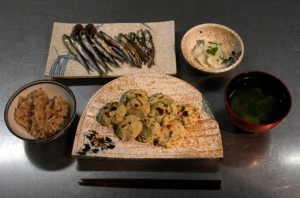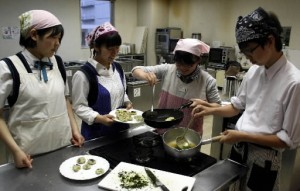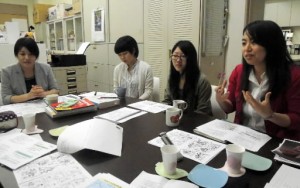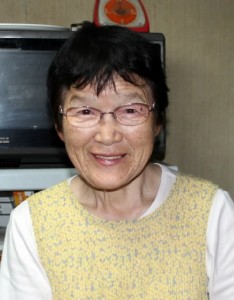Peace Seeds: Hiroshima Teens Report on Peace Issues, Part 4
Jun. 23, 2014
Food shortage during wartime gives rise to resourceful cooking
During World War II, food was rationed. There was widespread hunger, particularly in cities, due to the serious shortage of food. To prepare this article, the junior writers conducted interviews with people who are knowledgeable about that time. We also cooked meals that were commonly eaten during the war, as described in the manga “Kono Sekai no Katasumi ni” (“In One Corner of This World”), by Fumiyo Kono, born in Nishi Ward, Hiroshima, and we looked at their nutritional value. In the city of Hiroshima, which is intersected by seven rivers, people ate horseweed, wood sorrel, and other plants as well as what they could obtain from the rivers and the sea. They even made salt from the seawater. Their recipes, which did not waste food, teach us wisdom that can be useful in our lives today.
The junior writers prepare wartime recipes
Story by Sayaka Kawata and photographs by Kantaro Matsuo, first-year high school students
Tomoko Nishizaki, 48, of the Hiroshima Film Commission, located in Naka Ward, has experienced preparing wartime meals used in the making of films. She taught us how to cook meals that were actually eaten in those days. Food was scarce back then, and we learned that wood sorrel, field horsetails, and other plants were precious edibles.
The menu used only simple ingredients, but it took us a long time to prepare. The colors and nutritional balance were considered carefully, too. During the war, mothers came up with a variety of ideas for their meals, such as making stock from the seeds of pickled plums and increasing the volume of rice by adding water.
Ms. Nishizaki told us, “Through these meals, please imagine the hardship of those days. Mothers tried their best to prepare food, hoping that their children would enjoy eating it. Please think of the tragedy of the atomic bombing in which these mothers were deprived of their hope and their lives in an instant.”
Prefectural University of Hiroshima analyzes wartime meals
by Kohei Hayashi, first-year high school student, and Aoi Nakagawa, second-year junior high school student
Yuka Nishida, 39, an associate professor at the Prefectural University of Hiroshima’s Department of Health Sciences (Minami Ward), along with Ayaka Inamura, 22, Mizuki Ueda, 23, and Mana Morihiro, 21, fourth-year students of the department, told us that the wartime meals, like those prepared by junior writers, were poor in calories, protein, and fat.
The ingredients in the menu consisted mainly of carbohydrates. Sardines were the only source of protein. They did not use any oil or meat and the lack of calories led to slow growth and malnutrition. Because insufficient protein compromises the immune system, people became susceptible to tuberculosis and pneumonia, and many suffered from brain hemorrhage as their blood vessels grew weak.
There are, however, merits to these foods. Unpolished brown rice, sweet potatoes, and vegetables are rich in dietary fibers, which prevent colon cancer and other diseases. Brown rice is also rich in vitamin B1, which saccharizes carbohydrates. It could therefore provide supplemental nutrition that was lacking in the side dishes.
When it came to cooking methods, there were many ideas. The peeled skin of radishes was used, as were the seeds of pickled plums. These seeds removed the fishy odor from sardines and added salt and amino acid. Because roasted brown rice absorbs more water, it was boiled with three times as much water to add volume. In order to save miso (traditional Japanese seasoning made of fermented soybean paste), people used the water in which they had boiled sardines.
A-bomb survivor drank water when hungry
by Risa Murakoshi, third-year high school student, and Harumi Okada, first-year high school student
Terue Toda, 82, an A-bomb survivor who lived in Ujina-cho, Hiroshima (part of today’s Minami Ward), was 13 years old when the war ended. Because of the serious shortage of food, she recalls eating watery rice porridge almost every day, which had little rice and few ingredients.
Since food on the market was scarce, Ms. Toda’s mother grew vegetables such as radishes, Chinese cabbages, and sweet potatoes. The family ate porridge with the harvested vegetables and so little rice that the grains could be counted. As this was not enough food, they gathered the leaves and cones from field horsetails, young brackens, and other plants that grew on the riverbank by Miyuki Bridge, near their home. They also found short-necked clams, crayfish, and sea lettuce in the river.
When they were hungry, they drank a lot of water. The adults told children not to run because if they ran, they felt hungrier.
They could not buy any seasonings. They made salt, scooping water from the Kyobashi River, then let the water evaporate or boiled it down in a pan. Miso and soy sauce were also homemade.
After the war ended, when Ms. Toda tried to donate blood, she was told that her blood was too thin to be accepted. She believes this was due to the poor nutrition she had as a child.
Junior Writers’ Comments
I learned a lot about how people lived during the war. I never had an opportunity like this before. Back then, Ms. Toda lived in an area which is close to where I live now, so I felt a strong connection to what she said. It’s different when we have peace education lessons at school. I sometimes find crabs that come to our parking space, but we don’t eat them. I let them go in the river. (Harumi Okada, first-year high school student)
The menu we tried tasted good, which I hadn’t expected. The vegetables were prepared in a tasty way. When we roasted the brown rice, the grains popped a little, like popcorn. It was fun. We’re lucky to have so much food today. I have to appreciate the fact that I can eat every day without worries. From now on, I’ll try to finish eating everything I’m given. (Sayaka Kawata, first-year high school student)
Ms. Nishida taught us a lot, including difficult things like nutrition, in a way that was easy to understand for junior high school students. It was the first time I had been to the campus of the Prefectural University of Hiroshima. The teacher’s office was bright, which was a little different from what I had imagined. I was surprised by so many things. (Aoi Nakagawa, second-year junior high school student)
I came away from our interview thinking that we have to show more interest in food and be more thankful for the food we can eat. I’ll try not to be so picky. I don’t like lettuce that much, but I’ll try to finish it, too. (Kohei Hayashi, first-year high school student)
Personally, I liked the sweet potato biscuits best. During the war, when people couldn’t get nutritious food, they tried various ways to prepare food to satisfy their families as much as they could. It became clear to me that people of that time didn’t give up easily. (Kantaro Matsuo, first-year high school student)
(Originally published on June 23, 2014)











